Ocean microplastic pollution may be greater than estimated
The great diversity of scientific techniques and methods used in the study of marine microplastics pollution limits the current knowledge of this serious environmental problem threatening our ecosystems.

This is the main conclusion of a study carried out by the Institute of Environmental Science and Technology of the Universitat Autònoma de Barcelona (ICTA-UAB) that reviews the research carried out to measure the presence of microplastics in the coastal areas and seawater of the Mediterranean Sea, both in the sea surface water, seawater column and in marine sediments. The conclusions show that the levels of microplastics in the Mediterranean are probably higher than estimated, but the methods used are not capable of recording them.
Microplastic pollution is one of the environmental problems threatening our ecosystems, with a growing interest for society. Specifically, the Mediterranean Sea is one of the world's greatest plastic accumulation areas and presents pollution levels similar to the "great marine garbage patch" of the Pacific Ocean, since the large population that inhabits the area and the marine dynamics mean that floating plastics are trapped in the basin, with few possibilities of escaping into the Atlantic Ocean.
The scientific field that studies this problem is relatively new and its methods are constantly evolving, making it difficult to define the most appropriate terms and techniques with which to identify them. "Plastic materials are numerous and very diverse, with different characteristics that complicate having a standard framework to analyse them all in the same way. Moreover, additives such as pigments or retardants add further complexity", explains Laura Simon, ICTA-UAB researcher and first author of the study, published in the scientific journal Environmental Pollution.
The study states that the methods used in laboratories for sampling are very diverse, "and although this has made much progress in this scientific field, it has also meant that many of the data produced so far cannot be compared," she adds and acknowledges that this affects the current knowledge the scientific community has of this problem.
According to the research, of the 3,000 samples collected in the past decade, 82.8% were taken in coastal areas, so scientists have less evidence to understand the distribution of microplastics in the open sea. Also, nets with a mesh size of 200 microns or more were used to sample surface waters, so therefore smaller particles cannot be captured. Studies conducted to date estimate that the Mediterranean Sea contains 84,800 microplastics per km2 in its surface waters, around 300 microplastics per kilogram of marine sediment, and 59 microplastics per kilogram of beach sand. "The number of microplastics in the natural environment increases as their size decreases, therefore, the levels of microplastics in the Mediterranean are probably higher, but because of the methods used we are not able to record them," explains Dr. Patrizia Ziveri, head of the research line at ICTA-UAB.
Most plastics float in the sea. However, the seabed is considered the final dumping ground where microplastics are expected to accumulate. "We still have very little knowledge on the mechanisms that export microplastics from surface waters to the seafloor, for which we need more studies in the water column," says Dr. Michael Grelaud, researcher at ICTA-UAB.
Therefore, they stress the importance of defining a common framework to compare results and combine methods to be able to characterize the broad spectrum of plastic pollutants in the Mediterranean Sea and their potential impacts. They also call for greater international collaboration between Mediterranean countries, as currently the eastern part of the basin and North Africa have been sampled to a lesser extent.